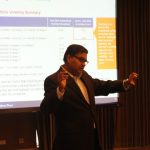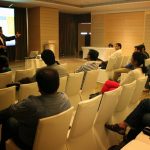- July 28, 2014
- Posted by: kunalsabnis
- Category:BLOG, Chennai, Events, Speaker Events
Contributed by – Meera Siva
Chennai chapter of the IAIP conducted an event on how to build investment solutions for global institutional investors and HNIs on July 19, 2014. The event addressed the challenges in building a portfolio, analytical tools that can help and the state of the industry in India. The speaker, Ravi A Gautham, CFA is a Senior Vice President at Northern Trust Company and the head of Northern Trust Asset Management in India. The company manages $950 billion in assets globally, of which over half is actively managed. He had earlier served as Senior Vice President and Director of Risk Management, at Northern Trust Global Advisors. Ravi holds MSc. (Hons.) in Economics and Management Studies from the Birla Institute of Technology & Science, Pilani, India and an MBA in Finance with a full research scholarship from the University of Toledo, Ohio. He is a CFA charter holder and a member of the CFA Association, the Chicago Society of Investment Analysts, as well as the Global Association of Risk Management Professionals.
The amount of assets that exist globally is estimated to be about $100 trillion. Of this around $6 trillion are in custody and can be invested. Institutional investors account for a large portion of the assets that are being managed with a large bulk of money in defined benefit pension funds. The contribution of private wealth from HNIs is increasing. Their needs are two fold – income generation for ongoing expenses such as country-club memberships and capital appreciation for large legacy projects such as creating a University endowment.
The large pool of money notwithstanding, you will find that the performance of active money management funds has been spotty over various time periods. Increasingly investors are asking the question – “why not go with passive management” and want to know if the higher fee paid is justified. So they are looking closely at factors which contribute to return and the risks associated with each of these components. The detailed analysis will help assess how best to meet returns and volatility goals. Also, you can understand that if some risks are already hedged by other investments and also if there are certain risk factors that we have doubled up on without being aware of it.
Investors are becoming more targeted and also more quantitative in assessments. Tools such as factor models help break down the returns and risks to do ‘attribution’ of the factors. You can see if the returns were due to some alpha seeking strategy or pure luck.
Take the case of measuring performance against a blended benchmark for a portfolio that has allocated 75/25 to equity and debt. You can reduce deviations from the benchmark by tracking it closely. Still, when you compare the asset returns to liabilities growth, the same portfolio may diverge widely from the target. This is because the liability, as in the case of defined contribution fund, has a more debt like quality and an asset portfolio which is tilted to equity may not hedge risks such as fall in interest rate.
Tools such as derivative strategies exist in the global markets to better hedge risks and to reduce asset liability mismatch. For instance, you can use tools such as credit default swaps, interest rate swaps to better manage your risks.
However, you will not find many such tools at your disposal in India. The amount of managed funds is also less. The money that is in the equity market is also not long term money, but rather FII funds that are short term. A lot of long term capital, which could provide a stable base for the equity market, is locked in Government bonds. Things may be changing, given that the NPS is now making the right moves to bring more funds to the market. Hopefully over the medium- to long-term, the managed investment landscape in India will evolve both in size and sophistication.


